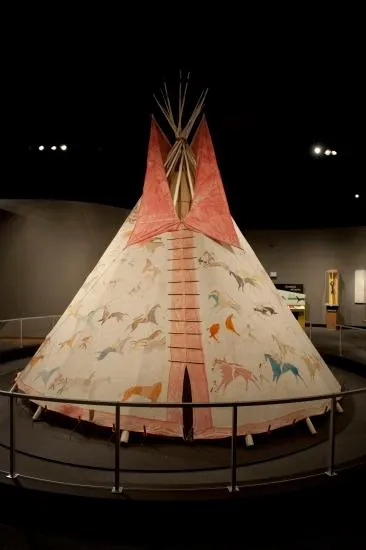“A Song for the Horse Nation” opens at the American Indian Museum
A new exhibition details the significant role of the horse in American Indian culture
/https://tf-cmsv2-smithsonianmag-media.s3.amazonaws.com/filer/20111028103005Drum-small.jpg)
It is hard to imagine any animal so thoroughly changing a culture as the horse did for Natives across America. Just decades after it was introduced, the horse had become indispensable for tribes throughout the West. The Lakota used horses to chase buffalo herds across the Great Plains, while the Cheyenne harnessed horses to travois sleds so they could transport goods over long distances. Horses shifted the balance of power between warring tribes, adorned artistic creations and became central figures in religious ceremonies.
Then, as quickly as the horse had come, its significance declined. “The horse culture ends up thriving for really only about 125 years,” says Emil Her Many Horses, a Lakota native and curator of the American Indian Museum‘s new exhibition, “A Song for the Horse Nation.” “The decline of the horse is when Native peoples were forced onto reservations, there’s a whole history about some of the horse herds being destroyed.”
“A Song for the Horse Nation” tells this story in thorough and often beautiful detail, through a range of artifacts, oral histories and multimedia. First displayed at the museum’s Heye Center, in New York City, the show has been expanded for its Washington D.C. location, incorporating new artifacts such as the Lakota tepee that serves as a centerpiece. Objects such as saddles, clothing, weapons and ornamental objects represent 38 different tribal communities.
Native Americans’ relationship with the horse began when Spanish conquistadors arrived, bringing the animal. (Ironically, a precursor of the European horse had evolved in North America, but had since gone extinct.) By capturing strays, raiding from Europeans and trading, Native communities acquired their own herds.
Different groups encountered the horse at different times, based on their geographic location and level of interaction with Europeans. “When dealing with Native histories, it’s hard to pin a specific date,” Her Many Horses says. “But as soon as they got the horse, it revolutionized everything.”

Horses were most deeply incorporated into life on the Great Plains, “On the plains, with the wide open spaces, you have an area to feed and water the horse,” says Her Many Horses. “You have available space to raise the animal, which was needed.” Tribes such as the Lakota and Crow bred large herds, which they used to travel wide distances, often following wild food sources such as buffalo. Horses soon dramatically altered the state of war, with warriors adopting the animals as a vehicle for sudden attacks and raids.
The use of horses in daily life declined over the course of the 20th century, as Native groups were forced onto reservations, and the automobile became the main mode of transportation. But the exhibition emphasizes how horses retain cultural significance in the communities.
One of the ways is through names. Among other background stories explaining horse-related family names is a display that touches on the personal background of the curator, Emil Her Many Horses. The horse plays a prominent role in his own family history:
“Tasunka Ota Win (Many Horses Woman) was the name of my great-great-grandmother, ” a placard reads. “She received her name because of the number of horses she owned. When the first census or enrollment was made on the Oglala Lakota reservation in South Dakota, her name became our family’s last name–but the census-takers mistranslated Tasunka Ota Win into English as Her Many Horses.”
Recent years have seen a resurgence in the actual use of horses on many reservations. “Although we no longer depend on horses for hunting and traveling, there are still some cultures—Crow, Nez Perce, Blackfeet, Lakota—that have strong horse herds,” Her Many Horses says. The exhibition details the Oomaka Tokatakiya (Future Generations Ride), a modern Lakota event on horseback which fosters leadership in youth, and includes a film on contemporary horse breeding on reservations.
The exhibition’s opening ceremonies will be held tomorrow, with a day of activities outside the museum. At 3 p.m., Crow equestrian Kennard Real Bird will bring the horse full circle, as he arrives in D.C. to officially open the exhibit by presenting the Crow Nation colors on horseback.
“A Song for the Horse Nation” is on display at the National Museum of the American Indian through January 7, 2013.
/https://tf-cmsv2-smithsonianmag-media.s3.amazonaws.com/accounts/headshot/joseph-stromberg-240.jpg)
/https://tf-cmsv2-smithsonianmag-media.s3.amazonaws.com/accounts/headshot/joseph-stromberg-240.jpg)